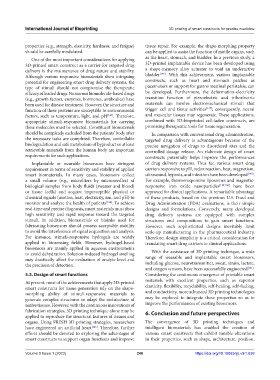Page 256 - IJB-9-1
P. 256
International Journal of Bioprinting 3D printing of smart constructs for precise medicine
properties (e.g., strength, elasticity, hardness, and fatigue) tissue repair. For example, the shape-morphing property
should be carefully modulated. can be applied to assist the function of motile organs, such
One of the most important considerations for applying as the heart, stomach, and bladder. In a previous study, a
3D-printed smart construct as a carrier for targeted drug 3D-printed implantable device has been developed using
delivery is the maintenance of drug nature and stability. a shape-memory alloy actuator to void an underactive
Although various responsive biomaterials show intriguing bladder [146] . With this achievement, various implantable
potential for engineering smart drug delivery systems, the constructs, such as heart and stomach patches as
type of stimuli should not compromise the therapeutic pacemakers or support for gastrointestinal peristalsis, can
efficacy of loaded drugs. Numerous biomolecule-based drugs be developed. Furthermore, the deformation-electricity
(e.g., growth factors, enzymes, hormones, antibodies) have transition function of piezoelectric and triboelectric
been used for disease treatment. However, the structure and materials can involve electromechanical stimuli that
function of these proteins are susceptible to environmental trigger cell and tissue activities [147] ; consequently, neural
factors, such as temperature, light, and pH [143] . Therefore, and muscular tissues may regenerate. These applications,
appropriate stimuli-responsive biomaterials for carrying combined with 3D-bioprinted cell-laden constructs, are
these molecules must be selected. Constituent biomaterials promising therapeutic tools for tissue regeneration.
should be completely excluded from the patients’ body after In comparison with conventional drug administration,
the necessary tasks are completed. Therefore, controllable targeted drug delivery is advantageous because of the
biodegradation and safe metabolism of byproduct or at least precise navigation of drugs to disordered sites and the
retrievable materials from the human body are important controlled dosage release. An elaborate design of smart
requirements for such applications. constructs potentially helps improve the performances
Implantable or wearable biosensors have stringent of drug delivery systems. Thus far, various smart drug
requirement in terms of sensitivity and stability of applied carriers responsive to pH, redox reaction, heat, magnetism,
smart biomaterials. In many cases, biosensors collect ultrasound, hypoxia, and infection have been developed [148] .
a small volume (e.g., microliters by microneedles) of For example, thermoresponsive liposomes and magnetic-
biological samples from body fluids (sweater and blood) responsive iron oxide nanoparticles [149,150] have been
or tissue (cells) and acquire imperceptible physical or approved for clinical applications. A remarkable advantage
chemical signals (motion, heat, electricity, ion, and pH) to of these products, based on the previous U.S. Food and
monitor and analyze the health of patients [144] . To achieve Drug Administration (FDA) evaluations, is their simple
real-time and precise diagnosis, smart materials must show designs and formulations. Conversely, many developed
high sensitivity and rapid response toward the targeted drug delivery systems are equipped with complex
stimuli. In addition, biomaterials or bioinks used for structures and compositions to gain smart functions.
fabricating biosensors should possess acceptable stability However, such sophisticated designs inevitably limit
to avoid the interference of signal acquisition and analysis. scale-up manufacturing in the pharmaceutical industry.
For instance, stimuli-responsive hydrogels are widely Therefore, design simplicity is a critical consideration for
applied in biosensing fields. However, hydrogel-based translating smart drug carriers to clinical applications.
biosensors are mainly applied in aqueous environments
to avoid dehydration. Solution-induced hydrogel swelling With the assistance of 3D printing technique, a wide
may drastically affect the evaluation of analyte level and range of wearable and implantable smart biosensors,
the precision of detection. including glucose, neurotransmitter, sweat, strain, lactate,
and oxygen sensors, have been successfully engineered [151] .
5.3. Design of smart functions Considering the continuous emergence of printable smart
At present, most of the achievements that apply 3D-printed materials with excellent properties, such as superior
smart constructs for tissue generation rely on the shape- elasticity, flexibility, recyclability, self-healing, self-fueling,
morphing ability of stimuli-responsive materials to and conductivity, more advanced 3D printing technologies
generate complex structures or adapt the architecture of may be explored to integrate these properties so as to
native tissues. However, with the continuous innovations of improve the performances of existing biosensors.
fabrication strategies, 3D printing technique alone may be 6. Conclusion and future perspectives
applied to reproduce the structural features of tissues and
organs. Using FRESH 3D printing strategies, researchers The convergence of 3D printing techniques and
have engineered an artificial heart [145] . Therefore, further intelligent biomaterials has enabled the creation of
efforts should be devoted to exploring the advantages of various smart constructs that exhibit tunable alterations
smart constructs to support organ functions and improve in their properties, such as shape, architecture, position,
Volume 9 Issue 1 (2023) 248 https://doi.org/10.18063/ijb.v9i1.638

